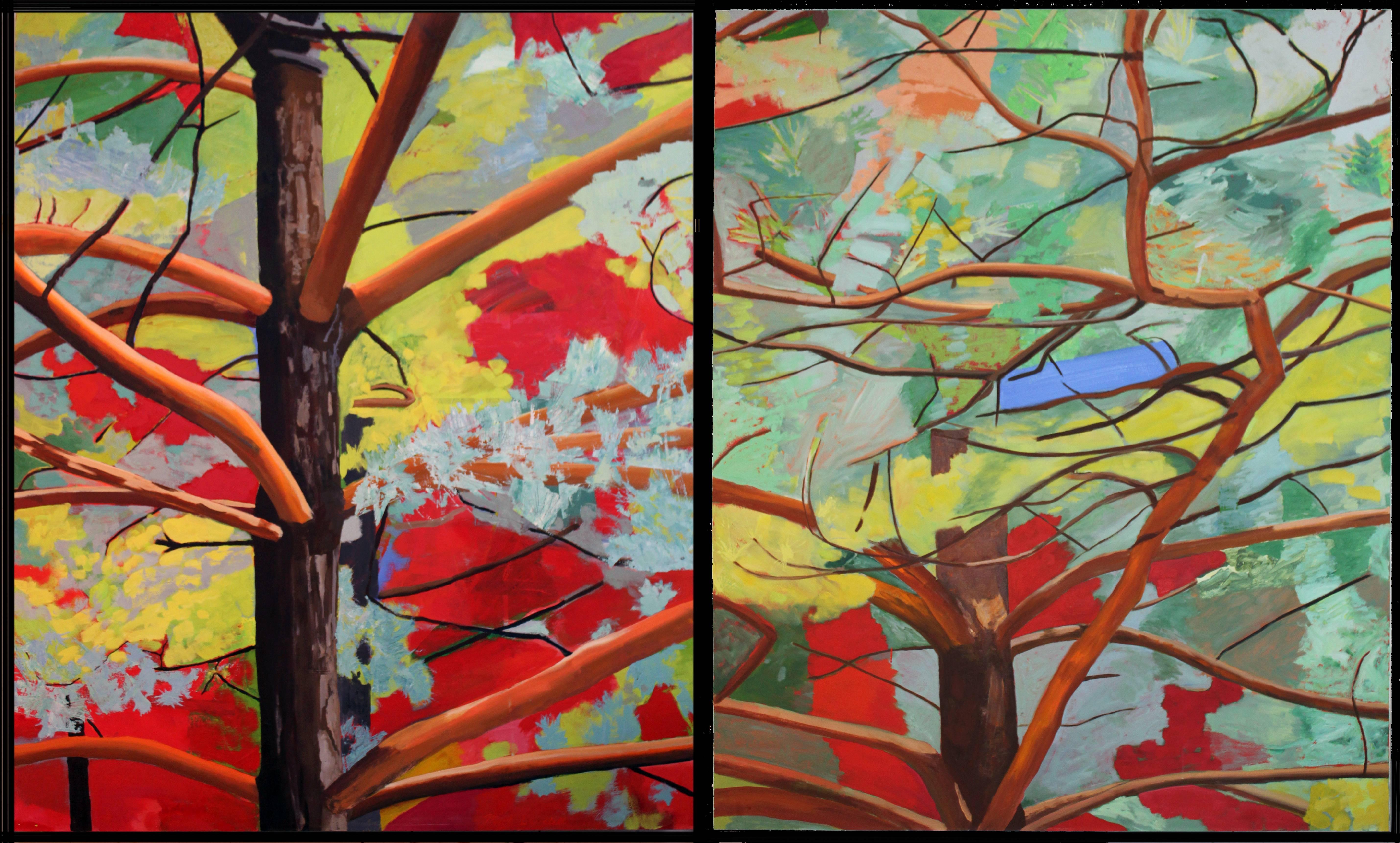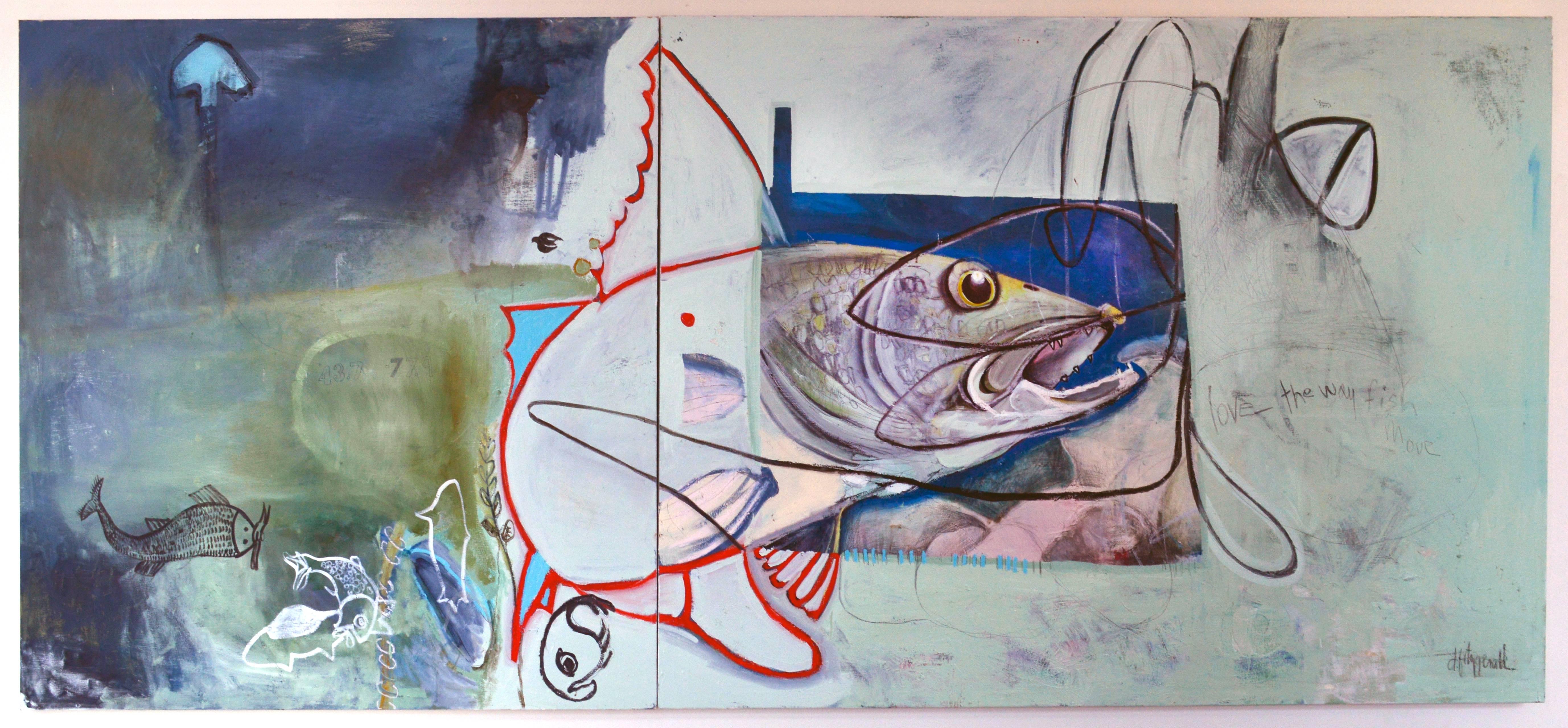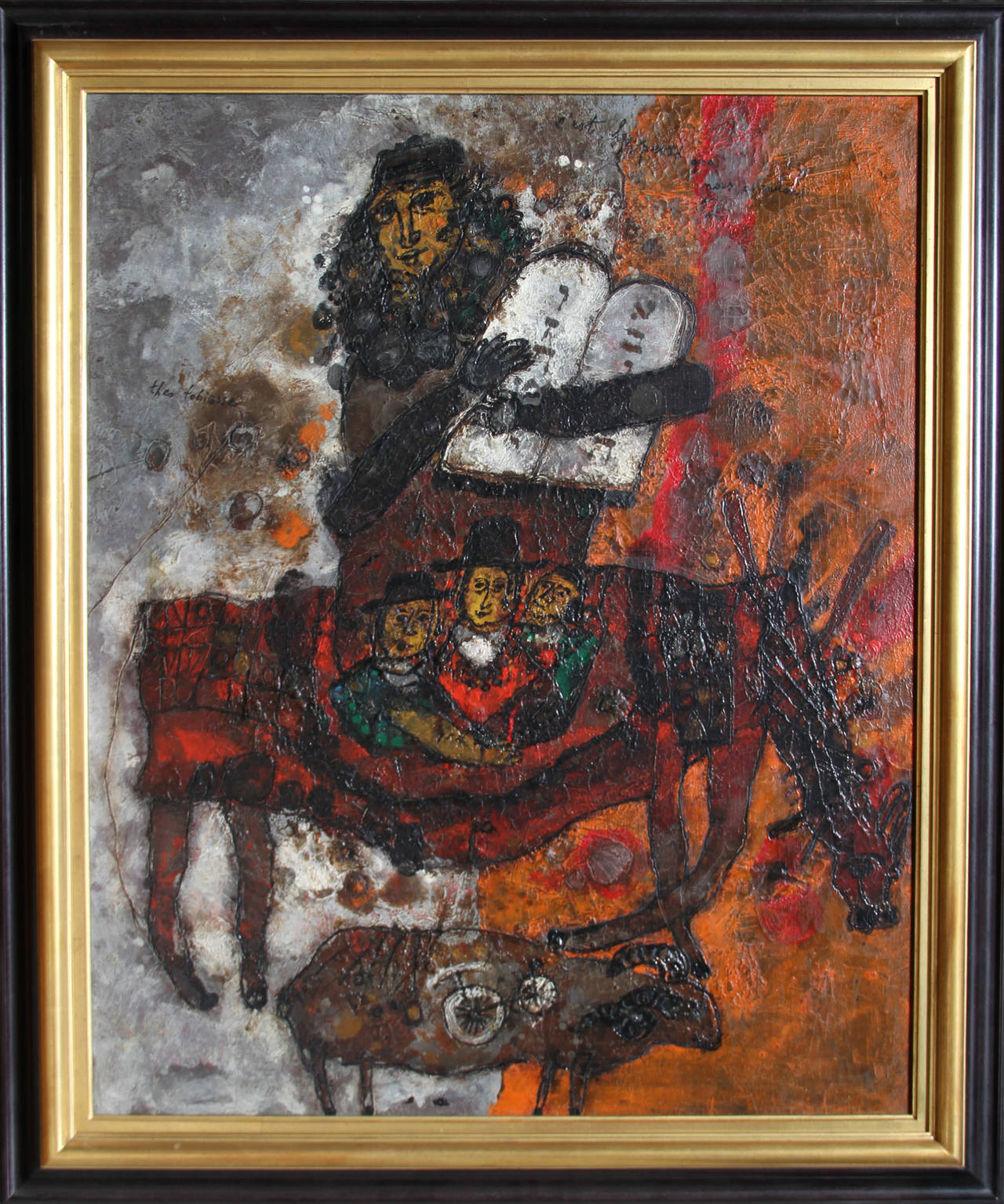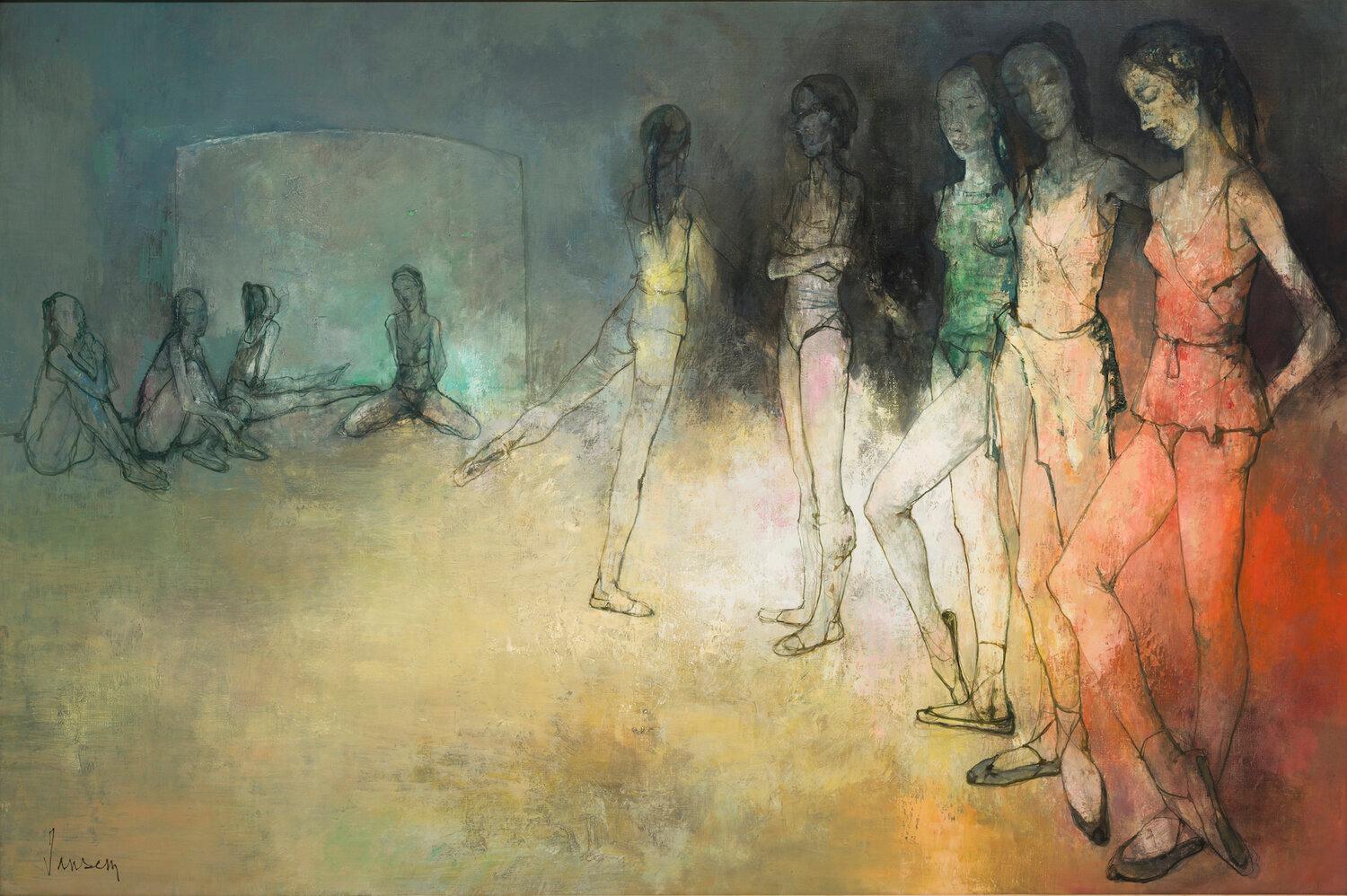Michael Baxte"Artist Painting Still Life" Expressionistic Style Oil Painting on CanvasMid-20th Century
Mid-20th Century
About the Item
- Creator:Michael Baxte (1890 - 1972, Russian)
- Creation Year:Mid-20th Century
- Dimensions:Height: 32 in (81.28 cm)Width: 25.5 in (64.77 cm)Depth: 1 in (2.54 cm)
- Medium:
- Movement & Style:
- Period:
- Framing:Framing Options Available
- Condition:This piece is in excellent condition besides some wear on outer edge of the canvas from age.
- Gallery Location:New York, NY
- Reference Number:
Michael Baxte
Michael Baxte was an American painter. His work was part of the painting event in the art competition at the 1936 Summer Olympics. During the 1930s Baxte and his wife, Violet, lived in France and spent most of their time in Paris, where Baxte became part of the School of Paris and exhibited his artwork in government-sponsored exhibitions, including the Salon d'Automne, helping as well to organize an exhibition of American painters. When World War II began, and Paris became unsafe, Baxte and his wife relocated to Mexico, where they continued to live and work. Baxte died in 1972 in Mexico.
- ShippingRetrieving quote...Ships From: New York, NY
- Return PolicyA return for this item may be initiated within 7 days of delivery.
- "Landscape Scene of Mexican Villagers" Expressionistic Oil Painting on MasoniteBy Michael BaxteLocated in New York, NYA strong modernist oil painting depicted in 1971 by Russian painter Michael Baxte. Mostly known for his abstracted figures on canvas or street scenes, this piece is a wonderful representation of his landscape paintings, with expressive use of color, shape, and form. Later in his career, Baxte explores Expressionism, infusing both European and North American stylistic trends. This piece is from later in his career, but we can feel this underlying style throughout. Art measures 18 x 21.75 inches Michael Posner Baxte was born in 1890 in the small town of Staroselje Belarus, Russia. For the first half of the 19th century it was a center of the Chabad movement of Hasidic Jews, but this group was gone by the middle of the 19th century. By the time the Baxte family immigrated to the United States at the beginning of the 20th century, the Jewish population numbered only on the hundreds. The native language of the Baxte family was Yiddish. It is likely that the death of Michael Baxte’s father triggered the family’s immigration. Three older brothers arrived in New York between 1903 and 1905. Michael and his mother, Rebecca, arrived in 1907. By 1910 Michael, his mother, and brother, Joseph, were living in New Orleans and may have spent some time on a Louisiana plantation. Around 1912, Michael Baxte returned to Europe to study the violin. In 1914 he, his mother, and Joseph moved to New York City. Meanwhile, in Algeria, a talented young woman painter, Violette Mege, was making history. Since for the first time, a woman won the prestigious Beaux Art competition in Algeria. At first, the awards committee denied her the prize but, with French government intervention, Mege eventually prevailed. She won again 3 years later and, in 1916, used the scholarship to visit the United States of America. When Violette came to New York, she met Baxte, who was, by then, an accomplished violinist, teacher, and composer. Baxte’s compositions were performed at the Tokyo Imperial Theater, and in 1922 he was listed in the American Jewish Yearbook as one of the prominent members of the American Jewish community. As a music teacher he encouraged individual expression. Baxte stated, “No pupil should ever be forced into imitation of the teacher. Art is a personal experience, and the teacher’s truest aim must be to awaken this light of personality through the patient light of science.” By 1920 Michael Baxte and Violette Mege were living together in Manhattan. Although they claimed to be living as husband and wife, it seems that their marriage did not become official until 1928. On their “unofficial” honeymoon around 1917, in Algiers, Baxte confided to her his ambition to paint. There and later in New Mexico where the wonderful steeped sunlight approximates the coloring of Algiers, she taught him his heart’s desire. He never had any other teacher. She never had any other pupil. For ten years she devoted all her time, energy, and ambition to teaching, encouraging, inspiring him. Then in 1928, their mutual strivings were rewarded, as his works were being chosen as one of the two winners in the Dudensing National Competition for American Painters. Out of 150 artists from across the country participated in the Dudensing, and Michael Posner Baxte and, Robert Fawcett, were the winners. In his 1924 naturalization application, he indicated that he was sometimes known as “Michael Posner Baxte.” One of the witnesses to his application was Bernard Karfiol, a Jewish American artist. That’s when Michael may...Category
1960s Expressionist Landscape Paintings
MaterialsMasonite, Oil
- "Landscape Scene of Fisherman by Lake" Expressionistic Oil Painting on MasoniteBy Michael BaxteLocated in New York, NYA strong modernist oil painting depicted in 1963 by Russian painter Michael Baxte. Mostly known for his abstracted figures on canvas or street scenes, this piece is a wonderful representation of his figures in water landscapes with expressive use of color, shape, and form. Later in his career, Baxte explores Expressionism, infusing both European and North American stylistic trends. This piece is from later in his career, but we can feel this underlying style throughout. Art measures 18 x 21.75 inches Michael Posner Baxte was born in 1890 in the small town of Staroselje Belarus, Russia. For the first half of the 19th century it was a center of the Chabad movement of Hasidic Jews, but this group was gone by the middle of the 19th century. By the time the Baxte family immigrated to the United States at the beginning of the 20th century, the Jewish population numbered only on the hundreds. The native language of the Baxte family was Yiddish. It is likely that the death of Michael Baxte’s father triggered the family’s immigration. Three older brothers arrived in New York between 1903 and 1905. Michael and his mother, Rebecca, arrived in 1907. By 1910 Michael, his mother, and brother, Joseph, were living in New Orleans and may have spent some time on a Louisiana plantation. Around 1912, Michael Baxte returned to Europe to study the violin. In 1914 he, his mother, and Joseph moved to New York City. Meanwhile, in Algeria, a talented young woman painter, Violette Mege, was making history. Since for the first time, a woman won the prestigious Beaux Art competition in Algeria. At first, the awards committee denied her the prize but, with French government intervention, Mege eventually prevailed. She won again 3 years later and, in 1916, used the scholarship to visit the United States of America. When Violette came to New York, she met Baxte, who was, by then, an accomplished violinist, teacher, and composer. Baxte’s compositions were performed at the Tokyo Imperial Theater, and in 1922 he was listed in the American Jewish Yearbook as one of the prominent members of the American Jewish community. As a music teacher he encouraged individual expression. Baxte stated, “No pupil should ever be forced into imitation of the teacher. Art is a personal experience, and the teacher’s truest aim must be to awaken this light of personality through the patient light of science.” By 1920 Michael Baxte and Violette Mege were living together in Manhattan. Although they claimed to be living as husband and wife, it seems that their marriage did not become official until 1928. On their “unofficial” honeymoon around 1917, in Algiers, Baxte confided to her his ambition to paint. There and later in New Mexico where the wonderful steeped sunlight approximates the coloring of Algiers, she taught him his heart’s desire. He never had any other teacher. She never had any other pupil. For ten years she devoted all her time, energy, and ambition to teaching, encouraging, inspiring him. Then in 1928, their mutual strivings were rewarded, as his works were being chosen as one of the two winners in the Dudensing National Competition for American Painters. Out of 150 artists from across the country participated in the Dudensing, and Michael Posner Baxte and, Robert Fawcett, were the winners. In his 1924 naturalization application, he indicated that he was sometimes known as “Michael Posner Baxte.” One of the witnesses to his application was Bernard Karfiol, a Jewish American artist. That’s when Michael may...Category
1960s Expressionist Landscape Paintings
MaterialsMasonite, Oil
- "Mexican Outdoor Scene with Figures" Expressionistic Style Oil Painting on BoardBy Michael BaxteLocated in New York, NYA strong modernist oil painting depicted in the Mid Century by Russian painter Michael Baxte. Mostly known for his abstracted figures on canvas or street scenes, this piece is a wond...Category
1960s Expressionist Landscape Paintings
MaterialsOil, Masonite
- "Pescadores" Expressionistic Style Mexican Scene by the Water with FishermenBy Michael BaxteLocated in New York, NYA strong modernist oil painting depicted in the Mid Century by Russian painter Michael Baxte. Mostly known for his abstracted figures on canvas or street scenes, this piece is a wond...Category
1950s Expressionist Landscape Paintings
MaterialsOil, Masonite
- "Mexican Landscape Scene with Female Figures and Child" Expressionistic StyleBy Michael BaxteLocated in New York, NYA strong modernist oil painting depicted in the Mid Century by Russian painter Michael Baxte. Mostly known for his abstracted figures on canvas or street scenes, this piece is a wond...Category
1970s Expressionist Figurative Paintings
MaterialsOil, Masonite
- "Mexican Interior Scene Scene with Figures and Fish" Expressionistic StyleBy Michael BaxteLocated in New York, NYA strong modernist oil painting depicted in the Mid Century by Russian painter Michael Baxte. Mostly known for his abstracted figures on canvas or street scenes, this piece is a wond...Category
1950s Expressionist Portrait Paintings
MaterialsOil, Masonite
- HavenBy Mark LavatelliLocated in Buffalo, NYAn original oil on canvas diptych by American contemporary artist Mark Lavatelli created in 1996. 72" X 122"Category
1990s Expressionist Figurative Paintings
MaterialsCanvas, Oil
- They found the pike but it wasn’t aloneBy Dorothy FitzgeraldLocated in Buffalo, NYAn original oil, oil stick and charcoal diptych painting on canvas by Contemporary female artist Dorothy Fitzgerald. This monumental work measures 60" (h) x 120" (w) This work was featured in the recent exhibition of The Corridors Gallery at Hotel Henry...Category
2010s Expressionist Figurative Paintings
MaterialsCanvas, Mixed Media, Oil
- C'est le Passe que Nous AttendonsBy Théo TobiasseLocated in Long Island City, NYAn oil painting by Theo Tobiasse from 1967. An expressionist-style textural painting of intensely dark and vivid color palette. Inspired from the artist's personal experiences of the...Category
1960s Expressionist Figurative Paintings
MaterialsOil, Canvas
- Le triomphe de la mort, 2000, oil on canvas by Jean JansemBy Jean JansemLocated in Carouge GE, GEJean Jansem (1920-2013) Le triomphe de la mort, 2000 Huile sur toile Signée en bas à gauche et à droite 150 x 200 cm Bibliographie: Cette oeuvre est enregistrée dans les archives de l’Association des Amis de Jean Jansem. Figurera dans le catalogue critique de l’oeuvre de Jean Jansem actuellement en préparation par l’association des amis de Jean Jansem Historique: L’indigence d’après-guerre et la difficulté inhérente de trouver les matériaux adéquats et/ou habituels, telles les couleurs, très onéreuses alors, ont poussé les artistes figuratifs de l’après-guerre, en corrélation avec les préoccupations de l’époque, à redéfinir les paradigmes de la représentation. Il n’est plus question de chercher un sens mais bien pour les artistes d'étudier l’objet pour son intérêt formel, sa qualité intrinsèque. Le regard de l’artiste devient analytique et dépeint alors l’objet pour ce qu’il est et non plus pour son pouvoir évocateur ou symbolique. La nature morte n’est plus une invitation sensuelle à la ripaille, la pomme ou la pêche n’évoque aucune envie de croquer, la cruche aucune ivresse, la volaille...Category
Late 20th Century Expressionist Figurative Paintings
MaterialsCanvas, Oil
- La salle de répétition de l'opéra de Paris, 1968, oil on canvas by Jean JansemBy Jean JansemLocated in Carouge GE, GEJean Jansem (1920-2013) La salle de répétition de l’Opéra de Paris, 1968 Huile sur toile Signée en bas à gauche 130 x 195 cm Provenance: Wally Findlay Galleries, New York Bibliographie: Cette oeuvre est enregistrée dans les archives de l’Association des Amis de Jean Jansem. Figurera dans le catalogue critique de l’oeuvre de Jean Jansem actuellement en préparation par l’association des amis de Jean Jansem Historique: 1964: c’est l’inauguration du nouveau plafond du Palais Garnier par Marc Chagall commandé par André Malraux alors ministre chargé des affaires culturelles. Commande qui fera couler beaucoup d’encre entre les partisans du modernisme et les tenants du conservatisme. Malraux tiendra bon, si ce n’est une légère concession: pour éviter de détruire l'ancien plafond et son décor, il sera masqué par une toile amovible de quelques 240m2 réalisée par Chagall dans les ateliers des Gobelins puis tendue par-dessus. Cette commande, autant acte politique que intellectuel, intervient à une époque où Malraux, convaincu que l’art contribue au rayonnement international de la France, soutiendra notamment les commandes du Mobilier national dont Pierre Paulin sera l’une des grandes figures, et où la CGT (Compagnie générale transatlantique) lancera un de ses plus gros chantiers avec le mythique paquebot France...Category
Late 20th Century Expressionist Figurative Paintings
MaterialsCanvas, Oil
- Le Nouvel Envol de l'Oiseau The New Flight of the Bird Oil on Linnen In StockBy CorneilleLocated in Utrecht, NLLe Nouvel Envol de l'Oiseau The New Flight of the Bird Oil on Linnen In Stock - Size Painting Without frame: 100 x 100 cm Popping with color, Corneille’s Expressionist paintings revolutionized the conservative Dutch art world of the 1950s. A part of the CoBrA art movement from 1948–51 together with Christian Dotremont, Asger Jorn, Constant, Karel Appel, and Pierre Alechinsky, Corneille shared the group’s influences: children’s art...Category
1970s Expressionist Figurative Paintings
MaterialsCanvas, Oil






